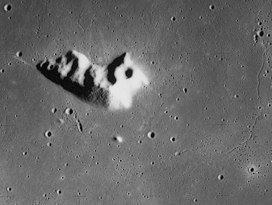
Carlini is a small lunar impact crater located in the Mare Imbrium. It was named after Italian astronomer Francesco Carlini. The crater is bowl-shaped with a small central floor. It has a higher albedo than the surrounding mare, making it prominent due to its isolated location. To the south is a wrinkle ridge named Dorsum Zirkel, and farther south lies the peak Mons La Hire.

Caventou is a tiny lunar impact crater located in the western part of the Mare Imbrium. It is a circular, cup-shaped formation surrounded by the lunar mare. It was named after French chemist Joseph B. Caventou in 1976. Prior to that, it had the designation La Hire D, being associated with the mountain Mons La Hire to the southeast.

Purbach is a large lunar impact crater in the rugged southern highlands of the Moon. The distorted crater Regiomontanus is attached to the southern rim. To the northwest is Thebit and just to the northeast lies La Caille.
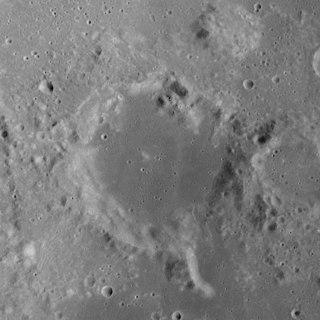
Maraldi is a worn, eroded crater on the western edge of the Sinus Amoris, in the northeast part of the Moon. To the west-southwest is the crater Vitruvius, and to the northwest lies the worn Littrow crater. Just to the northeast of the crater is the dome-like Mons Maraldi rise.

Vitruvius is a small lunar impact crater that lies on the northern edge of the Mare Tranquillitatis. To the east is the crater Gardner, and to the northeast is Fabbroni. To the north-northwest is the elongated Mons Vitruvius mountain, and beyond is the valley where the Apollo 17 mission landed.
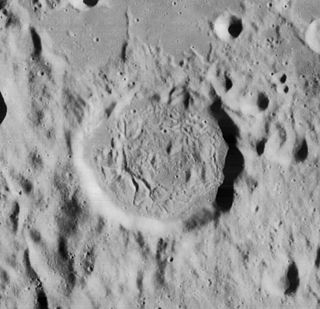
La Condamine is a small lunar impact crater that is located on the southern edge of the Mare Frigoris, in the northern part of the Moon. It lies to the northeast of the mountain-rimmed Sinus Iridum formation in the northwest part of the Mare Imbrium.

Franklin is a lunar impact crater that is located in the northeast part of the visible Moon; it is named after Benjamin Franklin. To the north-northwest is the smaller crater Cepheus, and in the opposite direction to the southwest is the shallow Berzelius.
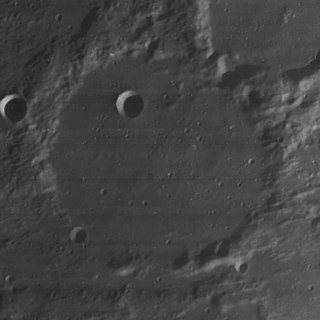
Arnold is a lunar impact crater that is located in the north-northeastern part of the visible Moon, near the lunar limb. This location gives the crater a notably oval appearance due to foreshortening, although the formation is actually relatively round. It lies to the northeast of the Mare Frigoris, to the north of the crater Democritus. West of Arnold is the smaller crater Moigno.

Boss is a lunar impact crater that is located along the northeast rim of the Moon's near side. Due to its location, the crater is viewed from the side by observers on the Earth, and its visibility is subject to libration effects.

Calippus is a small lunar impact crater that is located on the eastern edge of the rugged Montes Caucasus mountain range in the northern part of the Moon. It was named after Greek astronomer Callippus of Cyzicus. It lies to the southwest of the crater remnant Alexander, to the northwest of the Mare Serenitatis.
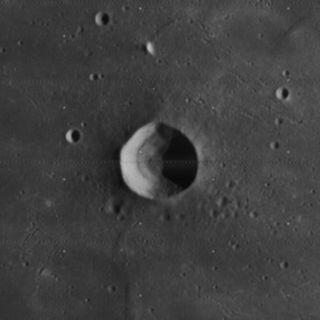
Kirch is a small lunar impact crater in the eastern part of the Mare Imbrium, a large lunar mare in the northwest quadrant of the Moon. It was named after German astronomer Gottfried Kirch. This is a relatively solitary formation with the nearest comparable crater being Piazzi Smyth to the northeast. Notable features in the vicinity are the Montes Spitzbergen mountains to the south and the solitary peak Mons Piton to the east-northeast. Kirch is circular and bowl-shaped, with a dark interior having the same albedo as the surrounding terrain.
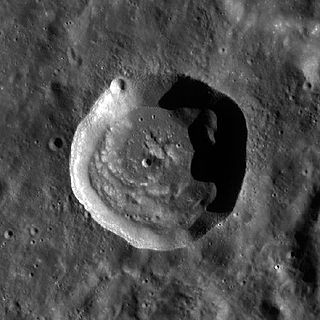
Chant is a lunar impact crater that is located on the far side of the Moon, behind the southwest limb as seen from the Earth. It lies within the southwestern part of the blanket of ejecta surrounding the Mare Orientale, beyond the Montes Cordillera mountain ring. To the west-northwest is the large walled plain Blackett. Southward is the crater Mendel.

Delaunay is a lunar impact crater. It was named after French astronomer Charles-Eugène Delaunay. The craters La Caille to the southwest and Faye to the northeast border on the outer rim of Delaunay. Further to the northwest is the prominent Arzachel.

Kapteyn is a lunar impact crater that is near the eastern limb of the Moon, to the west of the crater La Pérouse. West of Kapteyn is the slightly smaller Barkla, and farther to the west-northwest is the prominent Langrenus. Von Behring is to the north-northeast.

Faye is a heavily eroded lunar impact crater in the rugged southern highlands of the Moon. It is named after French astronomer Hervé Faye. It is attached to the northeastern rim of the crater Delaunay, with Donati located just a few kilometers to the northeast. It forms part of a chain of craters of increasing size to the southwest that continues with La Caille and ends with the walled plain Purbach.

Mons Hadley is a massif in the northern portion of the Montes Apenninus, a range in the northern hemisphere of the Moon. It has a height of 4.5 km (2.8 mi) 14,764 ft (4,500 m) above the adjacent plain and a maximum diameter of 25 km at the base.
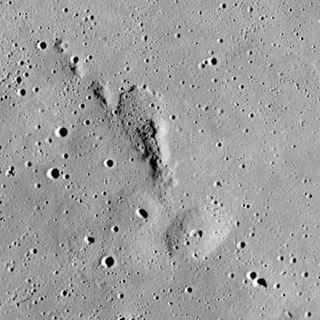
Mons Esam is a small, isolated mountain in the northern part of the Mare Tranquillitatis. It is located to the southeast of the crater Vitruvius and to the west-northwest of Lyell. To the northeast of this ridge is the bay called Sinus Amoris.

Mons Vinogradov is a rugged massif that is located on the lunar mare where Oceanus Procellarum to the southwest joins Mare Imbrium to the east. There are three primary peaks in this formation, which rise to altitudes of 1.0–1.4 km above the surface. To the east of this rise is the crater Euler, and to the southeast is an area of rugged ground that reaches the Montes Carpatus range. The Carpatus mountain range forms the southwest boundary of the Mare Imbrium.

Mons Bradley is a lunar mountain massif in the Montes Apenninus range, along the eastern edge of the Mare Imbrium. It is located to the west of the crater Conon. To the west of this peak is the Rima Bradley rille.

Cassini is a lunar impact crater that is located in the Palus Nebularum, at the eastern end of Mare Imbrium. The crater was named after astronomers Giovanni Cassini and Jacques Cassini. To the northeast is the Promontorium Agassiz, the southern tip of the Montes Alpes mountain range. South by south-east of Cassini is the crater Theaetetus. To the northwest is the lone peak Mons Piton.
